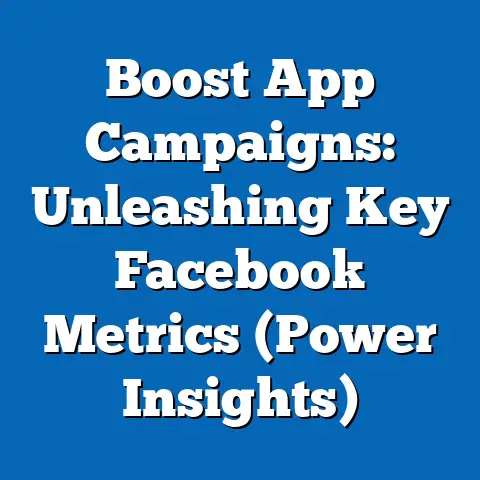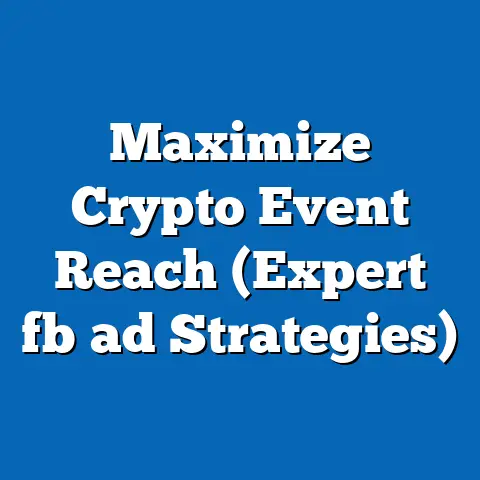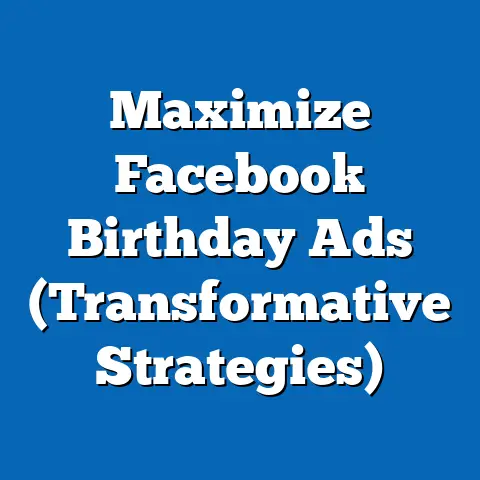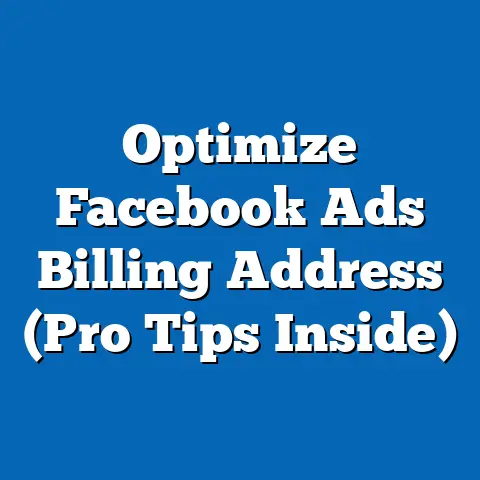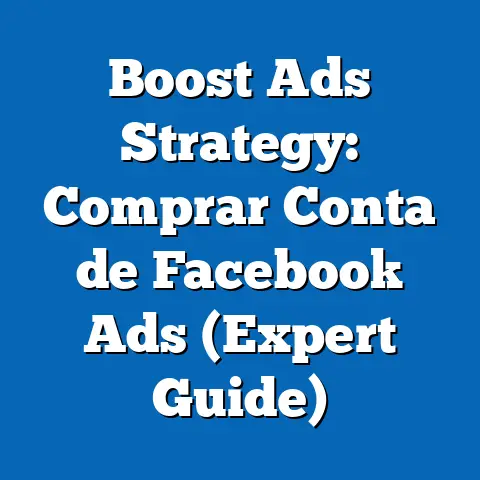Unlock the Magic of Facebook Ads (Proven Success Strategies)
Hey there! I still remember when I first started tinkering with Facebook ads. It was back in 2010, and Facebook was a totally different beast. My initial attempts were, let’s just say, less than stellar. I targeted the wrong people, my ad copy was awful, and my budget vanished faster than ice cream on a summer day. But I didn’t give up. I saw the potential, the raw power of connecting with people on such a personal level. And over the years, through countless hours of testing, tweaking, and learning from my mistakes (and the successes!), I’ve developed a deep understanding of what makes Facebook ads truly work.
Facebook has evolved from a simple platform for sharing photos and updates into a global marketplace, connecting billions of people. And in this digital age, mastering Facebook advertising isn’t just an option; it’s a necessity for businesses looking to thrive. With over 2.9 billion monthly active users (as of early 2024), Facebook offers an unparalleled opportunity to reach a vast and diverse audience. Think about it: that’s nearly half the planet! Statistically, Facebook ads can reach 33.9% of the world’s population, which means that your potential customers are likely scrolling through their feeds right now.
My goal is simple: to empower you with the knowledge and tools you need to create Facebook ad campaigns that not only get noticed but also deliver real, measurable results. So, buckle up, grab a coffee, and let’s dive into the world of Facebook ads!
Understanding Facebook Ads
Before we get into the nitty-gritty of crafting compelling ads and optimizing budgets, it’s crucial to have a solid understanding of the fundamentals of Facebook advertising. Think of it as laying the groundwork for a strong and successful campaign.
The Basics of Facebook Advertising
At its core, Facebook advertising allows you to promote your business, products, or services to a highly targeted audience on the Facebook platform. Unlike traditional advertising methods, Facebook ads offer incredible precision in targeting, enabling you to reach people based on their demographics, interests, behaviors, and more.
Here’s a breakdown of the different types of Facebook ads you can create:
-
Image Ads: These are the simplest form of Facebook ads, featuring a single image along with ad copy. They’re great for showcasing products or services in a visually appealing way.
-
Video Ads: Video ads are incredibly engaging and can be used to tell stories, demonstrate products, or share testimonials. They’re perfect for capturing attention and conveying complex information.
-
Carousel Ads: Carousel ads allow you to display multiple images or videos in a single ad unit, each with its own headline, description, and link. They’re ideal for showcasing a range of products or highlighting different features of a single product.
-
Slideshow Ads: Slideshow ads combine multiple images or videos into a dynamic slideshow format. They’re a cost-effective way to create engaging video-like content without the need for professional video production.
-
Collection Ads: Collection ads are designed for e-commerce businesses and allow you to showcase a catalog of products in a visually appealing format. They’re perfect for driving traffic to your online store and increasing sales.
-
Instant Experience Ads: Formerly known as Canvas ads, Instant Experience ads provide a full-screen, immersive experience that loads instantly when someone clicks on your ad. They’re great for telling compelling stories and showcasing products in an interactive way.
Image Ads: These are the simplest form of Facebook ads, featuring a single image along with ad copy. They’re great for showcasing products or services in a visually appealing way.
Video Ads: Video ads are incredibly engaging and can be used to tell stories, demonstrate products, or share testimonials. They’re perfect for capturing attention and conveying complex information.
Carousel Ads: Carousel ads allow you to display multiple images or videos in a single ad unit, each with its own headline, description, and link. They’re ideal for showcasing a range of products or highlighting different features of a single product.
Slideshow Ads: Slideshow ads combine multiple images or videos into a dynamic slideshow format. They’re a cost-effective way to create engaging video-like content without the need for professional video production.
Collection Ads: Collection ads are designed for e-commerce businesses and allow you to showcase a catalog of products in a visually appealing format. They’re perfect for driving traffic to your online store and increasing sales.
Instant Experience Ads: Formerly known as Canvas ads, Instant Experience ads provide a full-screen, immersive experience that loads instantly when someone clicks on your ad. They’re great for telling compelling stories and showcasing products in an interactive way.
Each ad type has its own unique strengths and is suited for different campaign objectives. I’ve found that using a mix of ad types, based on the specific goals of my campaigns, yields the best results. For example, when launching a new product, I often start with video ads to generate awareness and then follow up with carousel ads to showcase specific features.
Target Audience Insights
One of the most powerful aspects of Facebook advertising is its ability to target specific audiences with incredible precision. This means you can ensure that your ads are seen by the people who are most likely to be interested in your products or services.
Here’s a look at the different targeting options available on Facebook:
- Demographics: Target people based on their age, gender, education, location, relationship status, and more.
- Interests: Reach people based on their interests, hobbies, and the things they like on Facebook.
- Behaviors: Target people based on their past behaviors, such as purchase history, device usage, and travel habits.
- Custom Audiences: Create custom audiences based on your existing customer data, such as email lists or website visitors.
- Lookalike Audiences: Expand your reach by targeting people who are similar to your existing customers.
I’ve learned that understanding your audience is the key to successful Facebook advertising. Before launching any campaign, I spend time researching my target audience, identifying their needs, desires, and pain points. I use this information to create highly targeted ads that resonate with them on a personal level.
For example, if I’m selling a fitness product, I might target people who are interested in fitness, health, and wellness, and who have shown an interest in related products or services. I might also create a custom audience based on my existing customer list and then create a lookalike audience to reach new customers who are similar to my existing ones.
The Ad Creation Process
The ad creation process in Facebook Ads Manager can seem daunting at first, but once you get the hang of it, it becomes second nature. Here’s a step-by-step guide to creating your first Facebook ad campaign:
- Go to Facebook Ads Manager: Access Ads Manager through your Facebook business page.
- Choose Your Campaign Objective: Select the objective that aligns with your business goals, such as awareness, traffic, engagement, leads, or sales.
- Define Your Audience: Choose your target audience based on demographics, interests, behaviors, or create custom or lookalike audiences.
- Set Your Budget and Schedule: Determine your daily or lifetime budget and set the start and end dates for your campaign.
- Choose Your Ad Placement: Select where you want your ads to appear, such as Facebook, Instagram, Audience Network, or Messenger.
- Create Your Ad: Choose your ad format, upload your images or videos, and write your ad copy.
- Review and Publish: Review your ad settings and publish your campaign.
It’s important to note that Facebook’s algorithm is constantly evolving, so it’s crucial to stay up-to-date with the latest best practices and guidelines. I recommend regularly checking Facebook’s Business Help Center and following industry blogs and forums to stay informed.
Key Takeaway: Understanding the basics of Facebook advertising, including the different ad types, targeting options, and ad creation process, is essential for creating successful campaigns.
Crafting Compelling Ads
Now that we’ve covered the fundamentals of Facebook advertising, let’s dive into the art of crafting compelling ads that capture attention, engage your audience, and drive results. This is where your creativity and understanding of your target audience really come into play.
Visual Appeal
In the fast-paced world of social media, visuals are king. Your ad’s image or video is the first thing people will see, so it needs to be eye-catching and relevant to your target audience.
Here are some tips for selecting visuals that resonate with your audience and reflect your brand:
- Use High-Quality Images and Videos: Ensure that your visuals are clear, crisp, and visually appealing. Avoid using blurry or pixelated images.
- Showcase Your Product or Service: Highlight the key features and benefits of your product or service in your visuals.
- Use Authentic Imagery: Avoid using stock photos that look generic or staged. Instead, opt for authentic images that showcase real people using your product or service.
- Tell a Story: Use visuals to tell a story that resonates with your target audience and evokes emotion.
- Keep it Consistent with Your Brand: Ensure that your visuals align with your brand’s overall aesthetic and messaging.
I’ve found that using visuals that feature real people, especially customers, tends to perform well. People are more likely to trust and engage with ads that feel authentic and relatable. For example, if I’m selling a skincare product, I might use images of real customers showcasing their before-and-after results.
Copy That Converts
While visuals are important, your ad copy is what seals the deal. Your ad copy should be engaging, persuasive, and relevant to your target audience.
Here are some strategies for writing ad copy that converts:
- Start with a Compelling Headline: Your headline is the first thing people will read, so it needs to be attention-grabbing and relevant to your target audience.
- Highlight the Benefits, Not Just Features: Focus on the benefits that your product or service provides, rather than just listing its features.
- Use a Clear and Concise Call-to-Action: Tell people exactly what you want them to do, such as “Shop Now,” “Learn More,” or “Sign Up Today.”
- Use Persuasive Language: Use words that evoke emotion and create a sense of urgency, such as “Limited Time Offer,” “Don’t Miss Out,” or “Get Yours Now.”
- Keep it Authentic: Be genuine and transparent in your ad copy. Avoid making false claims or exaggerating the benefits of your product or service.
One of the most effective techniques I’ve learned is to speak directly to my target audience’s pain points. By addressing their specific needs and desires, I can create ad copy that resonates with them on a personal level and motivates them to take action.
For example, if I’m selling a time management tool, I might use a headline like “Are You Overwhelmed by Your To-Do List?” This immediately grabs the attention of people who are struggling with time management and makes them more likely to read the rest of my ad copy.
A/B Testing
A/B testing, also known as split testing, is the process of testing different variations of your ads to see which ones perform best. By testing different elements of your ads, such as headlines, images, and calls-to-action, you can optimize your campaigns for maximum performance.
Here are some elements you can test in your Facebook ads:
- Headlines: Test different headlines to see which ones grab the most attention and generate the most clicks.
- Images: Test different images to see which ones resonate best with your target audience.
- Ad Copy: Test different ad copy variations to see which ones are most persuasive and generate the most conversions.
- Calls-to-Action: Test different calls-to-action to see which ones drive the most engagement and conversions.
- Targeting Options: Test different targeting options to see which ones reach the most relevant audience.
I always recommend starting with a clear hypothesis before conducting any A/B tests. For example, “I believe that using a video ad will generate more engagement than using an image ad.” This will help you focus your testing efforts and ensure that you’re measuring the right metrics.
When conducting A/B tests, it’s important to only test one element at a time. This will allow you to accurately measure the impact of each element on your ad performance. It’s also important to run your tests for a sufficient amount of time to gather enough data to draw meaningful conclusions.
Key Takeaway: Crafting compelling ads requires a combination of visual appeal, persuasive ad copy, and continuous A/B testing. By focusing on these elements, you can create ads that capture attention, engage your audience, and drive results.
Budgeting and Bidding Strategies
Now that you know how to create compelling ads, let’s talk about how to budget your campaigns and choose the right bidding strategies to maximize your return on investment (ROI). This is where the rubber meets the road, and it’s crucial to have a solid understanding of these concepts to avoid wasting money and ensure that your campaigns are profitable.
Understanding Budgeting Options
Facebook offers two main budgeting options: daily budgets and lifetime budgets.
- Daily Budget: A daily budget allows you to set a fixed amount that you’re willing to spend on your ads each day. This is a good option if you want to run your ads continuously and have a consistent flow of traffic and leads.
- Lifetime Budget: A lifetime budget allows you to set a total amount that you’re willing to spend on your ads over the entire duration of your campaign. This is a good option if you want to run your ads for a specific period of time, such as during a product launch or promotional campaign.
When determining an appropriate budget for your Facebook ads, it’s important to consider your business goals, target audience size, and the cost of acquiring a customer. I usually start with a small budget and gradually increase it as I see positive results.
I’ve found that it’s also helpful to use Facebook’s Budget Recommendation tool, which provides estimates of how much you should spend based on your target audience and campaign objectives. However, it’s important to remember that these are just estimates, and you should always adjust your budget based on your own results.
Bidding Strategies
Facebook offers a variety of bidding strategies to help you optimize your ad spend and achieve your campaign objectives.
Here are some of the most common bidding strategies:
- Cost Per Click (CPC): With CPC bidding, you pay each time someone clicks on your ad. This is a good option if you want to drive traffic to your website or landing page.
- Cost Per Impression (CPM): With CPM bidding, you pay for every 1,000 impressions your ad receives. This is a good option if you want to increase brand awareness and reach a large audience.
- Cost Per Action (CPA): With CPA bidding, you pay only when someone takes a specific action, such as making a purchase or filling out a form. This is a good option if you want to drive conversions and generate leads.
- Target Cost: With Target Cost bidding, you tell Facebook the average cost you’re willing to pay for a result, and Facebook will try to get you as many results as possible at or below that cost.
- Lowest Cost: With Lowest Cost bidding, Facebook will try to get you the most results possible for your budget, without regard to the cost per result.
The right bidding strategy for you will depend on your campaign objectives and your target audience. I usually start with CPC bidding when I’m trying to drive traffic to my website and then switch to CPA bidding once I have enough data to accurately estimate the cost of acquiring a customer.
Monitoring ROI
Tracking your ad performance and ROI is crucial for making informed decisions about your Facebook advertising campaigns. Facebook Insights provides a wealth of data about your ad performance, including impressions, clicks, conversions, and cost per result.
I recommend regularly monitoring your Facebook Insights to identify which ads are performing well and which ones need to be optimized. Pay close attention to the following metrics:
- Click-Through Rate (CTR): The percentage of people who click on your ad after seeing it. A high CTR indicates that your ad is relevant and engaging to your target audience.
- Conversion Rate: The percentage of people who take a desired action after clicking on your ad, such as making a purchase or filling out a form. A high conversion rate indicates that your landing page is effective and that your offer is compelling.
- Cost Per Result: The average cost you’re paying for each desired result, such as a click, conversion, or lead. A low cost per result indicates that your campaign is efficient and that you’re getting a good return on your investment.
- Return on Ad Spend (ROAS): The amount of revenue you’re generating for every dollar you spend on advertising. A high ROAS indicates that your campaign is profitable and that you’re generating a significant return on your investment.
By monitoring these metrics and making adjustments to your campaigns as needed, you can ensure that you’re maximizing your ROI and achieving your business goals.
Key Takeaway: Budgeting and bidding strategies are crucial for maximizing your ROI on Facebook ads. By understanding your budgeting options, choosing the right bidding strategies, and monitoring your ad performance, you can ensure that your campaigns are profitable and that you’re achieving your business goals.
Scaling Your Facebook Ads
Once you’ve created successful Facebook ads and are generating a positive ROI, it’s time to scale your campaigns and reach an even wider audience. Scaling your Facebook ads involves increasing your budget, expanding your targeting options, and leveraging seasonal opportunities.
Identifying Successful Ads
Before you start scaling your Facebook ads, it’s important to identify which ads are performing well and should be scaled. Look for ads that have a high CTR, conversion rate, and ROAS. These are the ads that are resonating with your target audience and generating the most results.
I usually create a spreadsheet to track the performance of my Facebook ads. I include metrics such as impressions, clicks, conversions, cost per result, and ROAS. This allows me to easily identify which ads are performing well and which ones need to be optimized or paused.
Once you’ve identified your successful ads, it’s time to start scaling them.
Expanding Your Reach
- Lookalike Audiences: Lookalike audiences allow you to target people who are similar to your existing customers. This is a great way to reach new customers who are likely to be interested in your products or services.
- Retargeting Ads: Retargeting ads allow you to target people who have previously interacted with your business, such as visiting your website or engaging with your Facebook page. This is a great way to re-engage potential customers who may have shown interest in your products or services but didn’t make a purchase.
- Geographic Targeting: Geographic targeting allows you to target people in specific locations. This is a great option if you want to reach customers in a particular city, state, or country.
- Interest-Based Targeting: Interest-based targeting allows you to target people based on their interests and hobbies. This is a great way to reach customers who are passionate about your niche.
I’ve found that using a combination of these strategies is the most effective way to expand my reach on Facebook. For example, I might create a lookalike audience based on my existing customer list and then use retargeting ads to target people who have visited my website but didn’t make a purchase.
Leveraging Seasonal Opportunities
Seasonal trends and events can provide a great opportunity to optimize your ad performance. For example, you might run special promotions or discounts during holidays such as Christmas, Black Friday, or Valentine’s Day.
I always plan my Facebook advertising campaigns around seasonal trends and events. I create ads that are relevant to the season and offer special promotions or discounts to attract customers. I also use seasonal keywords and hashtags in my ad copy to increase visibility.
For example, if I’m selling winter clothing, I might run a campaign during the winter holidays that offers discounts on winter coats and accessories. I would also use keywords such as “winter coats,” “holiday gifts,” and “Christmas sales” in my ad copy.
Key Takeaway: Scaling your Facebook ads involves identifying successful ads, expanding your reach, and leveraging seasonal opportunities. By using these strategies, you can reach a wider audience and generate even more results from your Facebook advertising campaigns.
Overcoming Common Challenges
While Facebook advertising can be incredibly effective, it’s not without its challenges. Ad fatigue, policy restrictions, and algorithm changes can all impact your ad performance and require you to adapt your strategies.
Ad Fatigue
Ad fatigue is a phenomenon that occurs when your target audience becomes tired of seeing the same ads over and over again. This can lead to a decrease in CTR, conversion rate, and ROAS.
Here are some strategies for combating ad fatigue:
- Creative Refreshes: Regularly update your ad creative with new images, videos, and ad copy. This will help keep your ads fresh and engaging.
- Audience Rotation: Rotate your target audience by targeting different demographics, interests, or behaviors. This will help you reach new customers and avoid exhausting your existing audience.
- Frequency Caps: Set frequency caps to limit the number of times people see your ads. This will help prevent ad fatigue and ensure that your ads are not annoying or intrusive.
- Ad Scheduling: Use ad scheduling to show your ads at different times of the day or week. This will help you reach customers when they’re most likely to be engaged.
I’ve found that creative refreshes are the most effective way to combat ad fatigue. I regularly update my ad creative with new images, videos, and ad copy to keep my ads fresh and engaging. I also use audience rotation to target different demographics, interests, or behaviors.
Navigating Policy Restrictions
Facebook has strict advertising policies that you must adhere to in order to avoid having your ads rejected or your account suspended. These policies cover a wide range of topics, including prohibited content, restricted content, and targeting guidelines.
Here are some tips for ensuring that your ads comply with Facebook’s advertising policies:
- Read the Policies Carefully: Familiarize yourself with Facebook’s advertising policies and guidelines before creating your ads.
- Avoid Prohibited Content: Do not promote content that is illegal, discriminatory, or offensive.
- Be Transparent: Be transparent about your products or services and avoid making false claims or exaggerating the benefits.
- Follow Targeting Guidelines: Follow Facebook’s targeting guidelines and avoid targeting sensitive categories such as race, ethnicity, or religion.
- Monitor Your Ads: Regularly monitor your ads to ensure that they comply with Facebook’s advertising policies.
I always double-check my ads to ensure that they comply with Facebook’s advertising policies before publishing them. I also monitor my ads regularly to ensure that they continue to comply with the policies.
Staying Updated with Changes
Facebook’s algorithm and advertising policies are constantly evolving, so it’s important to stay informed about the latest changes. This will help you adapt your strategies and avoid any negative impact on your ad performance.
Here are some resources for staying up-to-date with Facebook’s changes:
- Facebook Business Help Center: The Facebook Business Help Center provides a wealth of information about Facebook’s advertising features and policies.
- Facebook for Business Blog: The Facebook for Business Blog publishes articles and updates about Facebook’s advertising platform.
- Industry Blogs and Forums: Follow industry blogs and forums to stay informed about the latest trends and best practices in Facebook advertising.
- Facebook’s Marketing Science Team: Follow Facebook’s Marketing Science Team for research and insights into how people use Facebook and how to effectively advertise on the platform.
I regularly check these resources to stay informed about the latest changes in Facebook’s algorithm and advertising policies. I also attend industry conferences and webinars to learn from other experts and stay ahead of the curve.
Key Takeaway: Overcoming common challenges in Facebook advertising requires combating ad fatigue, navigating policy restrictions, and staying updated with changes. By using these strategies, you can minimize the impact of these challenges and continue to generate positive results from your Facebook advertising campaigns.
Conclusion
We’ve covered a lot of ground in this article, from understanding the basics of Facebook advertising to crafting compelling ads, optimizing budgets, scaling your campaigns, and overcoming common challenges. I hope that you now have a solid understanding of how to unlock the magic of Facebook ads and achieve your business goals.
Remember, the key to success in Facebook advertising is to understand your audience, create compelling ads, optimize your budget, and continuously test and refine your strategies. It’s also important to stay informed about the latest changes in Facebook’s algorithm and advertising policies and adapt your strategies accordingly.
I encourage you to take action and implement the strategies outlined in this article. Start small, test different approaches, and track your results. With dedication and the right approach, you can achieve significant success with Facebook ads and unlock the possibilities for your business growth.
So go ahead, embrace the magic of Facebook ads, and watch your business thrive! I’m confident that with the knowledge and tools you’ve gained from this article, you’re well on your way to creating Facebook ad campaigns that deliver real, measurable results. Good luck, and happy advertising!

